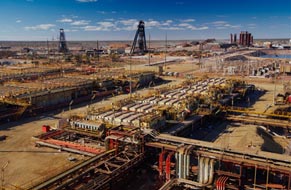The automated haulage system in the main shaft at the Olympic Dam underground mine in South Australia has been damaged by a mechanical failure, owner BHP Billiton reported. The company has not said when the system is likely to be working again, but expects investigations into the failure and its impact on operations to take around two weeks.
 |
| Olympic Dam (Image: BHP Billiton) |
BHP said that a full investigation is underway to determine the cause of the failure and the extent of the damage in the Clark shaft. No-one was injured in the incident, which occurred at about 10:30 p.m. on 6 October.
The company did not release details on the cause of the failure, but media reports suggest that a fully-loaded ore skip fell to the bottom of the 500-metre deep shaft, sending another skip on a linked cable flying up into the winding equipment at the top of the shaft, damaging the concrete walls of the shaft on its way.
The main shaft haulage system supplies ore from underground to the surface processing facilities. BHP said that the secondary haulage system, in the Whenan shaft, continues to operate. The Whenan shaft haulage system is reportedly primarily used to transport miners underground and is said to have a capacity of about one-third that of the Clark shaft system.
Whilst not disclosing when it expects the Clark shaft haulage system to be in operation again, the company said, "The safety of our workforce will take priority in determining any restart of haulage operations." BHP Billiton said that the company is working with inspectors from SafeWork SA, South Australia's occupational health and safety agency, and has also assembled its own investigation team.
The company said that the mine's planning team "is currently examining what impact the temporary closure of the Clark shaft will have on mine production, planning schedule and budget." It added that this work, to run in parallel with the government and company investigations, is "expected to be completed in the course of the next two weeks."
"A lengthy repair time could force BHP to declare force majeure on uranium sales from the project, the supplier of about 10% of the world’s mine production of the radioactive material, assuming stockpiles at the remote mine site ... are limited," a report in The Age newspaper suggested.
Olympic Dam is a multi-mineral ore deposit some 560 km north of Adelaide. It is the world's largest known uranium orebody, as well as laying claim to the world's fourth largest remaining copper deposit, fifth largest gold deposit and significant quantities of silver. It produces uranium as a co-product with copper. Metallurgical recovery of uranium is only 73%, due to much of the uranium mineralisation being brannerite, from which uranium is difficult to extract (uranium is usually liberated from the host mineral by dissolving it in acid, but brannerite is more resistant to acid dissolution than other uranium-bearing minerals).
The mine produced 3344 tU in 2008, winning it fourth place in the world's top ten uranium mines and accounting for 8% of total world uranium production. However, BHP Billiton is looking to massively increase the size of the mine over coming decades, and earlier this year released a 4000-page draft environmental impact statement (EIS) on its proposed expansion plans. Government decisions on the draft EIS are expected by the middle of 2010. The proposed expansion would take 11 years to implement, and would see production of up to 19,000 tonnes U3O8 per year.





_69614.jpg)

_15447.jpg)




